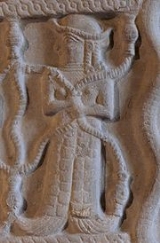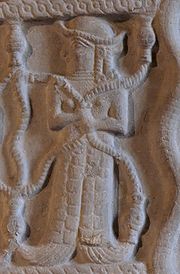
Untash-Napirisha
Encyclopedia

Elam
Elam was an ancient civilization located in what is now southwest Iran. Elam was centered in the far west and the southwest of modern-day Iran, stretching from the lowlands of Khuzestan and Ilam Province, as well as a small part of southern Iraq...
(in present day southwest Iran) from about 1275 to 1240 BC.
He was the son of the previous king, Khumban-Numena. His original name was 'Untash-Khumban
Khumban
Khumban is the Elamite god of the sky. His sumerian equivalent is Anu.Several Elamite kings, mostly from the Neo-Elamite period, were named in honour of Khumban....
', but out of respect, he later changed the last half of his name to napirisha (Elamite
Elamite language
Elamite is an extinct language spoken by the ancient Elamites. Elamite was the primary language in present day Iran from 2800–550 BCE. The last written records in Elamite appear about the time of the conquest of the Persian Empire by Alexander the Great....
for 'great God'). Today, he is best known for building the religious complex Dur Untash (Choqa Zanbil
Choqa Zanbil
Chogha Zanbil ; Elamite: Dur Untash) is an ancient Elamite complex in the Khuzestan province of Iran.It is one of the few existent ziggurats outside of Mesopotamia...
).
Although construction in this religious city complex abruptly ended after Untash-Napirisha's death, the site was not abandoned, but continued to be occupied until it was destroyed by the Assyria
Assyria
Assyria was a Semitic Akkadian kingdom, extant as a nation state from the mid–23rd century BC to 608 BC centred on the Upper Tigris river, in northern Mesopotamia , that came to rule regional empires a number of times through history. It was named for its original capital, the ancient city of Assur...
n king Ashurbanipal
Ashurbanipal
Ashurbanipal |Ashur]] is creator of an heir"; 685 BC – c. 627 BC), also spelled Assurbanipal or Ashshurbanipal, was an Assyrian king, the son of Esarhaddon and the last great king of the Neo-Assyrian Empire...
in 640 BC. Some scholars speculate, based on the large number of temples and sanctuaries at Choqa Zanbil, that Untash-Napirisha attempted to create a new religious center (possibly intended to replace Susa
Susa
Susa was an ancient city of the Elamite, Persian and Parthian empires of Iran. It is located in the lower Zagros Mountains about east of the Tigris River, between the Karkheh and Dez Rivers....
) which would unite the Gods of both highland and lowland Elam at one site.

